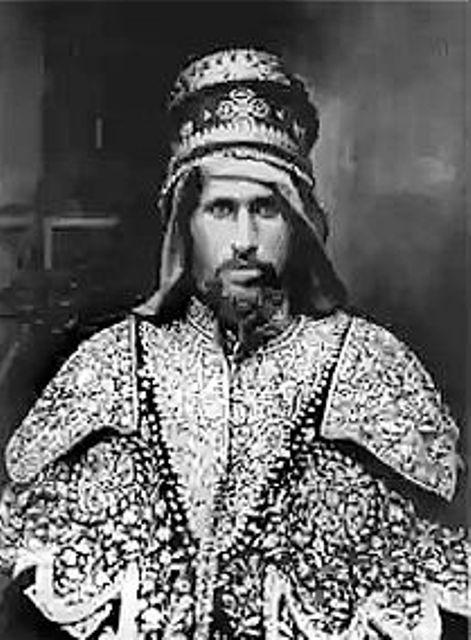
Negus Tekle Haymanot (Teklehaymanot) Tessemma
Negus Tekle Haymanot Tessema was born with the name of Adal Tessemma. His father Negus or King Tessemma Goshu was the Governor of Gojjam which was ultimately under the control of the Ethiopian Emperors.As a young boy, his father died leaving him vulnerable to his enemies, one of which was Ras Desta Tedla a Prince of Gojjam, who took control and put young Adal in jail.
As he got older, Adal would escape and return with an army to banish Ras Desta and take his birth right as ruler of Gojjam.
He achieved this by pledging allegiance to Emperor Tekle Giorgis, who gave him the title of Governor or Shum of Gojjam as well as making him a Dejazmach.
Emperor Tekle Giorgis also gave Dejazmach Adal his daughter Laketch Gebremedhin for marriage, uniting their bloodlines.
Ras Desta, his old enemy returned to power in Gojjam by 1871 with the defeat of Emperor Tekle Giorgis at the hands of Dejazmach Kassay Mercha who went on to become Emperor Yohannes IV.
Once again Dejazmach Adal returned and this time put an end to Ras Desta's life, therefore, putting all of Gojam under his authority.
Dejazmach Adal went on to pledge his loyalty to Emperor Yohannes IV, who then made him Ras Tekle Haymanot Tessemma, and a little while later in 1881, King or Negus of Gojjam and Kaffa, if he could conquer it.
In order to take control of the Kaffa province, he had to go against another man who was rising in power and prestige.
Ras Menelik the King or Negus of Shewa was determined to take power over the province of Kaffa and therefore went to battle Negus Tekle Haymanot.
With the assistance of about 8,000 rifles provided by Emperor Yohannes IV, the emboldened Negus Tekle Haymanot fought the overwhelmingly powerful forces of Negus Menelik who defeated and captured him in the Battle of Embabo in 1882.
Emperor Yohannes intervened on his behalf but by 1888 a Mahidist army from the Sudan attacked defeated Tekle Haymanot's army in Dembea, which led to the burning and looting of Gondar.
Emperor Yohannes IV asked Negus Menelik of Shewa to battle the Mahidists in Bejember and Gojjam.
Negus Tekle Haymanot and Negus Menelik saw an opportunity in the troubles Emperor Yohannes IV was facing around the country and attempted to align their forces.
Emperor Yohannes IV sensing the conspiracy with Negus Tekle Haymanot's refusal to send his soldiers to fight the Mahdists, entered Gojjam and destroyed it causing Negus Tekle Haymanot to pledge his loyalty once again.
By 1889, the death of Emperor Yohannes in the Battle of Gallabat found Negus Menelik proclaiming himself Emperor Menelik II and in turn, Negus Tekle Haymanot submitted to him and became Governor of Shum of Gojjam.
The Battle of Adwa during the First Italo-Abyssinian war found Negus Tekle Haymanot heroically fighting alongside Emperor Menelik, his contribution led to the first victory of an African army against a modern European nation.
After the death of Negus Tekle Haymanot, Gojjam was considered to important and powerful to be left in the hands of one man, and Emperor Menelik divided it up into three separate areas of control.

The residents of Debre Markos erected the Tekle Haymanot Arch in his remembrance.
